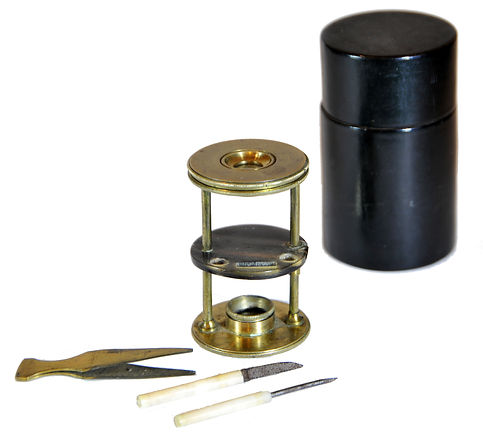

Withering-type botanical microscope, 1780
The “Withering-type Microscope” is named for its inventor, Dr. William Withering (1741-1799), an English physician and botanist who graduated with a degree in medicine 1766 in Edinburgh. Inspired by the taxonomical work and systematic classification of Carl Linnæus (1707-1778), Withering (1776) applied the Linnaean taxonomical system of classification to British plants in a seminal, two volume work, A Botanical arrangement of all the vegetables naturally growing in the British Isles. The earliest reference to a small botanical microscope of Withering’s design appeared in the first edition of this book. There, Withering indicated this microscope was developed for field dissections of flowers and other plant parts. While there is no surviving example of this exact design, close relatives of this type do exist, made either completely of brass or of ivory with brass pillars. Ivory models can be tentatively dated to 1776-1785, as by 1787 a newer model with a hollowed stage in an all-brass configuration already predominated. In turn, it was preceded by the brief appearance of a transitional brass model but with solid stage of ivory or horn (seen here). This version is extremely rare and must have been produced in very small numbers. By 1787 all these varieties were not recorded anymore in the literature.

Withering-type botanical microscope, 1780
The “Withering-type Microscope” is named for its inventor, Dr. William Withering (1741-1799), an English physician and botanist who graduated with a degree in medicine 1766 in Edinburgh. Inspired by the taxonomical work and systematic classification of Carl Linnæus (1707-1778), Withering (1776) applied the Linnaean taxonomical system of classification to British plants in a seminal, two volume work, A Botanical arrangement of all the vegetables naturally growing in the British Isles. The earliest reference to a small botanical microscope of Withering’s design appeared in the first edition of this book. There, Withering indicated this microscope was developed for field dissections of flowers and other plant parts. While there is no surviving example of this exact design, close relatives of this type do exist, made either completely of brass or of ivory with brass pillars. Ivory models can be tentatively dated to 1776-1785, as by 1787 a newer model with a hollowed stage in an all-brass configuration already predominated. In turn, it was preceded by the brief appearance of a transitional brass model but with solid stage of ivory or horn (seen here). This version is extremely rare and must have been produced in very small numbers. By 1787 all these varieties were not recorded anymore in the literature.
References: SML: A242712; Goren 2014.
References: SML: A242712; Goren 2014.
Prof. Yuval Goren's Collection of the History of the Microscope



© Microscope History all rights reserved
Double Column Microscope, ca. 1720
This microscope is a unique and intriguing device that can be traced back to the early 18th century. It features a single level of magnification and is constructed from materials commonly used in that era, including pasteboard, shagreen, ivory, wood, and brass. The microscope utilizes transmitted light for illumination, which is directed through a mirror—an invention credited to Edmund Culpeper in the early 1700s.
Focusing is achieved with a Hevelius screw. The stage and its mount remain fixed while turning the screw thread adjusts the optical tube up or down in relation to the specimen. Johannes Hevelius (1611-1687) improved the Hooke microscope by incorporating a fine-pitch thumbscrew for precise focusing. In this microscope, focus is adjusted using a milled ring attached to the tube, which is wrapped around a longer screw with a relatively coarse thread. This design facilitates quicker movement of the optical tube, which contains three optical elements: the eye lens, body lens, and object lens, providing approximately 100x magnification.
Although this system is subject to typical distortions of the period, such as chromatic and spherical aberrations, the optical quality is surprisingly good for the time it was likely created.
Determining the origin of this unique microscope is quite challenging. Archaeologists often joke that when they discover a rare artifact, they complain about its lack of parallels. This seems to apply to this microscope. While we can exclude a British origin, it is possible that the microscope originates from continental Europe, with potential sources including Holland, France, Italy, or the German lands. Another possibility is that it is a rare copy of European microscopes from Japan's Edo period, which also featured a two-legged base similar to that of this microscope. A good example of such a microscope can be seen here and in the period's picture. About Edo period microscopes in Japan, see here.
